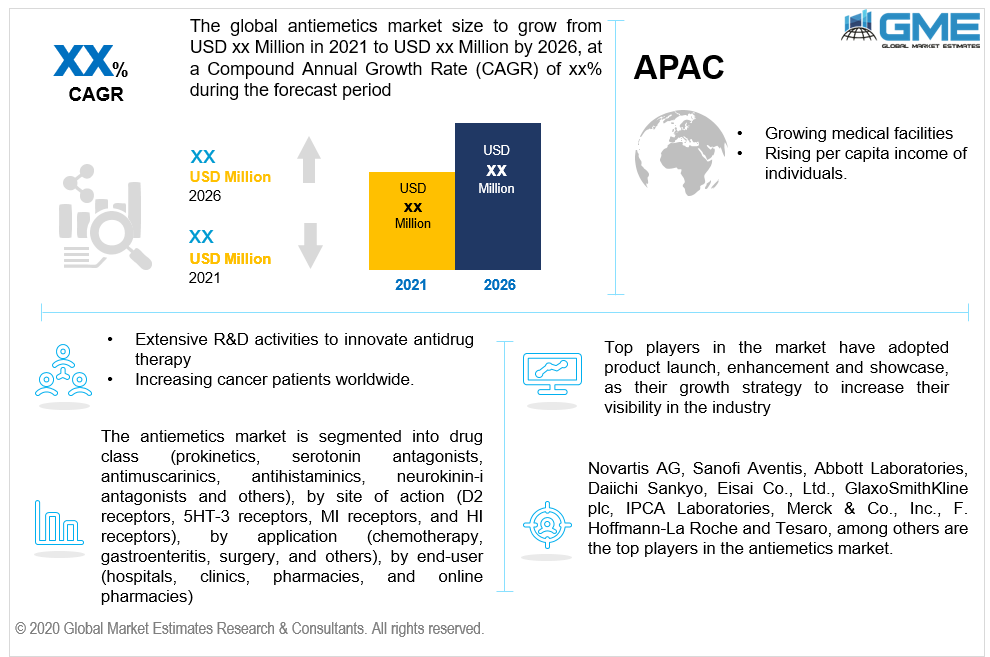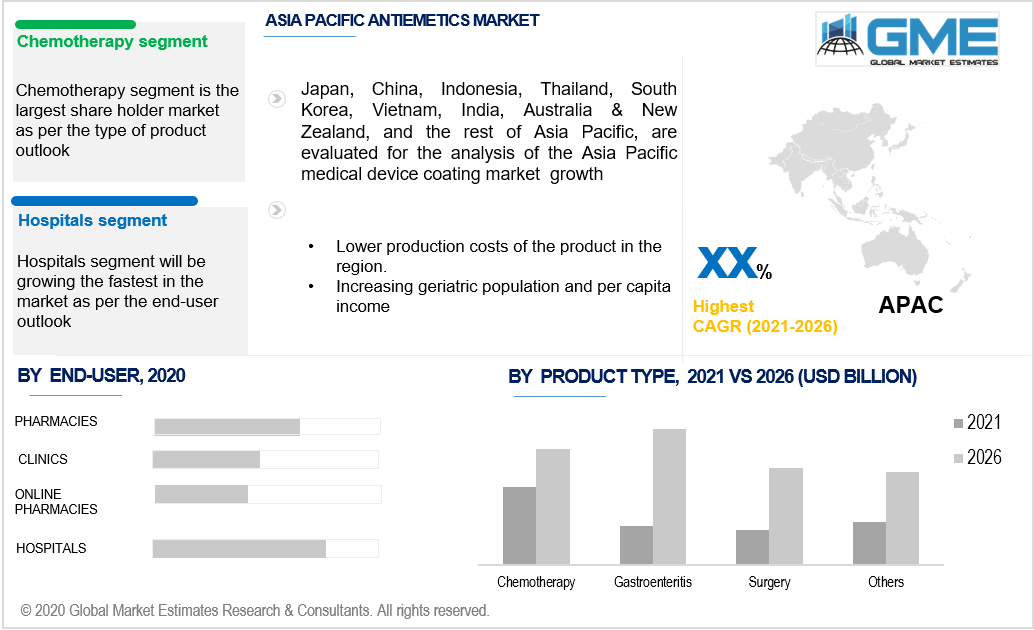
Global Antiemetics Market Size, Trends & Analysis - Forecast to 2026 By Drug Class (Prokinetics, Serotonin antagonists, Antimuscarinics, Antihistaminics, Neurokinin-I antagonists and Others), By Site of Action (D2 Receptors, 5HT-3 Receptors, MI Receptors, and HI Receptors), By Application (Chemotherapy, Gastroenteritis, Surgery, and Others), By End-User (Hospitals, Clinics, Pharmacies, and Online pharmacies), By Region (North America, Asia Pacific, Europe, Latin America, Middle East & Africa); End-User Landscape, Company Market Share Analysis, and Competitor Analysis
Antiemetics are antiemetic medications that help with nausea and vomiting. Antivertigo is another name for antiemetics. Motion sickness, breastfeeding, food poisoning, dizziness, and mental discomfort are only a few of the medical conditions that cause nausea and vomiting. These treatments are also used to relieve the adverse effects of various medicines such as opioid analgesics, chemotherapy, and general anesthesia.
Antiemetic medications offer exceptional comfort to pregnant women suffering from stomach pain in the first trimester of pregnancy. Antiemetic medications are very beneficial for women who have prolonged stomach pain. It is triggered by one of four trigger zones: Vestibular nuclei, Cerebral cortex, Gastrointestinal tract, and Chemoreceptor. It is regulated by histamine (H1), muscarinic (H2), and serotonin (5-HT3) receptors. To relieve the side effects of these medications, chemotherapy opioid analgesics, and general anesthetics are frequently used.
Antiemetic medicines are used to treat nausea and vomiting caused by other medications like those used for surgical anesthesia or cancer chemotherapy. Antiemetic medications are inhaled by mouth. They are often sprayed and most times applied to the body. Antiemetic medicines can be used in the case of gastroenteritis, particularly if the person is dehydrated. These treatments give exceptional support to pregnant women who suffer from stomach pain during the initial stages of their pregnancy. Furthermore, antiemetic medications are extremely beneficial for women whose morning sickness lasts for an extended period.
Some of the key market forces that are accelerating the antiemetics market are the increasing number of cancer patients worldwide along with gastroenteritis which is becoming more common and hence the demand for this product is rising on a day-to-day basis. Moreover, extensive research and development funding in the pharmaceutical sector to innovate antidrug therapy, as well as an increase in pregnancy-induced nausea and acute gastroenteritis, are all major factors affecting business growth. Furthermore, positive market growth is due to increasing demand for novel therapeutics and the rising prevalence of PONVis driving the market and will drive the market in the future too.Furthermore, the focus has increased on personalized medicines, and hence it acts as a boost to this market.Many new players are entering the market and hence it is a signal that the market will be growing in the future.

Based on the drug class, the antiemetics market can be segmented as prokinetics, serotonin antagonists, antimuscarinics, antihistaminics, neurokinin-i antagonists, and others. The serotonin antagonists segment will be having the largest share in the market during the predicted timeframe. It is a kind of drug that works by antagonizing serotonin receptors. Serotonin antagonists are the most common antipsychotics, and they have been used to treat anxiety, bipolar disorder, and stimulant psychosis. The dopaminergic pathway has been linked to several illnesses. The loss of serotonin pathways in the striatum causes Parkinson's disease.
Based on the site of action, the antiemetics market is divided into d2 receptors, 5ht-3 receptors, mi receptors, and hi receptors.During the projected era, the 5-HT3 receptor antagonists segment would have the biggest market share. These antagonists are used to control nausea and vomiting, especially those brought on by radiotherapy, chemotherapy, or surgery. 5-HT3 is also referred to as serotonin receptor antagonists or serotonin receptors.
Based on theapplication, the antiemetics market is classified aschemotherapy, gastroenteritis, surgery, and others. The chemotherapy segment is likely to rise during the predicted years. The segment will be having the largest share in the market as the number of cancer patients is rising day by day. People are more prone to diseases like cancer these days due to bad eating habits or inhaling of tobacco or due to hereditary reasons. Hence, this segment is likely to rise during the predicted period.
Based on end-user, the antiemetics market is segmented into Hospitals, Clinics, Pharmacies, and Online pharmacies.The pharmacy segment is likely to rise during the predicted years. Individuals prefer to purchase medicine from pharmacies by visiting the store. The doctor’s prescription is followed and hence the pharmacies will be keeping the drug and hence the market will be rising.
Online pharmacies have started rising due to many individuals ordering the medicines online to availvarious discounts, coupons, and offers. Further, people do not prefer to go out and purchase due to the COVID-19 pandemic, and hence the demand for online pharmacies has increased drastically.

As per the geographical analysis, the market can be classified into North America, Asia Pacific, Europe, Middle East & Africa, and Central South America.The North American region will dominate the market in terms of market share over the coming years owing to the higher incidence of patients undergoing chemotherapy and the availability of basic hospital facilities.
Europe is projected to be the second most lucrative area in the global antiemetic drugs market. APAC is projected to be the fastest-growing antiemetics industry due to the huge population in countries like India, Japan, China, and other developing Asian countries. APAC is seeing opportunities and constantly growing markets owing to factors such as a large population, developing per capita disposable incomes, increasing exposure among patients, low production costs, and rising demand for better pharmaceutical products.The Latin American market is expected to expand steadily, while the Middle East and Africa market is expected to be the least profitable.
Novartis AG, Abbott Laboratories, Daiichi Sankyo, Eisai Co., Ltd., GlaxoSmithKline plc, IPCA Laboratories, Sanofi Aventis, Merck & Co., Inc., F. Hoffmann-La Roche, and Tesaro are the top players in the Antiemetics Market.
Please note: This is not an exhaustive list of companies profiled in the report.
We value your investment and offer free customization with every report to fulfil your exact research needs.
The Global Antiemetics Market has been studied from the year 2019 till 2026. However, the CAGR provided in the report is from the year 2021 to 2026. The research methodology involved three stages: Desk research, Primary research, and Analysis & Output from the entire research process.

The desk research involved a robust background study which meant referring to paid and unpaid databases to understand the market dynamics; mapping contracts from press releases; identifying the key players in the market, studying their product portfolio, competition level, annual reports/SEC filings & investor presentations; and learning the demand and supply-side analysis for the Antiemetics Market.

The primary research activity included telephonic conversations with more than 50 tier 1 industry consultants, distributors, and end-use product manufacturers.

Finally, based on the above thorough research process, an in-depth analysis was carried out considering the following aspects: market attractiveness, current & future market trends, market share analysis, SWOT analysis of the company and customer analytics.

Tailor made solutions just for you
80% of our clients seek made-to-order reports. How do you want us to tailor yours?
OUR CLIENTS